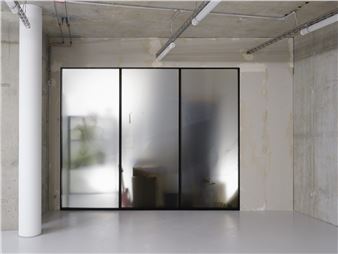Peppi Bottrop: How Long is Forgotten
One of contemporary culture’s greatest absurdities is its aspiration to make experience analyzable, calculable, and conservable. One of painting’s greatest promises is to vehemently oppose such presumptuousness. Against this backdrop, Peppi Bottrop’s first solo exhibition at Sies + Höke shouldn’t just be read as a pleasantly poetic twist, but also as a subversion of the conventional logic of time. How Long Is Forgotten? The entanglement of simple past and past participle produces a glitch that turns this inconspicuous question into a grammatical time warp; the message between the lines (and the times) is that past and present, forgetting and remembering, origin and utopia—in Bottrop’s images and in general—unfold according to their own incalculable dynamics.
Forgetting and remembering fundamentally oppose each other as antagonistic forces. Remembering is the maintenance, cultivation, and conservation of the past and identity. Forgetting, by contrast, creates the capacity for something new in a neurological sense. Remembering builds on continuity, forgetting causes a rupture. At the same time, the awareness that remembrances of our time perception can radically throw us out of step has been part of cultural memory since the publication of Marcel Proust’s novel À la recherche du temps perdu at the very latest. In order to verbally approximate the phenomenon of mémoires involontaires—memories that unexpectedly suspend temporal continuity—Proust formulated sentences that syntactically sprawl forth, branching off into nested moments. In Peppi Bottrop’s work, it’s the synaptic strokes that sprawl, entangled forms and structures. His mémoires involontaires are informed by the peripheries of the cities he’s recently lived and worked in—Düsseldorf, Los Angeles, Mexico City—but especially by the Ruhrgebiet’s rough industrial districts he grew up in.
Some works in the exhibition have the paradoxical attraction of an uncovered crash site. Aren’t there skid marks, the grill of a lorry’s ramp, the metal remains of a sports car’s body? Isn’t there the echo of frantic speed, red trickling into the ground, Soil of Reddish Hue?[1] The existential, the drama, Sorh?[2] Couldn’t How Long Is Forgotten be the question of a relative or loved one, asking in broken English how long the amnesia after the accident is likely to last? What really happened? The one responsible gave his fragmentary testimony: a dog bite, his right hand out of order. To give the bare canvas its first structure, he put it on a sheet of metal grating; the resulting impression was fixed with a rust converter, and he continued working on it once his hand was better—with graphite sticks, coal, acrylics.

Recommended for you
One of contemporary culture’s greatest absurdities is its aspiration to make experience analyzable, calculable, and conservable. One of painting’s greatest promises is to vehemently oppose such presumptuousness. Against this backdrop, Peppi Bottrop’s first solo exhibition at Sies + Höke shouldn’t just be read as a pleasantly poetic twist, but also as a subversion of the conventional logic of time. How Long Is Forgotten? The entanglement of simple past and past participle produces a glitch that turns this inconspicuous question into a grammatical time warp; the message between the lines (and the times) is that past and present, forgetting and remembering, origin and utopia—in Bottrop’s images and in general—unfold according to their own incalculable dynamics.
Forgetting and remembering fundamentally oppose each other as antagonistic forces. Remembering is the maintenance, cultivation, and conservation of the past and identity. Forgetting, by contrast, creates the capacity for something new in a neurological sense. Remembering builds on continuity, forgetting causes a rupture. At the same time, the awareness that remembrances of our time perception can radically throw us out of step has been part of cultural memory since the publication of Marcel Proust’s novel À la recherche du temps perdu at the very latest. In order to verbally approximate the phenomenon of mémoires involontaires—memories that unexpectedly suspend temporal continuity—Proust formulated sentences that syntactically sprawl forth, branching off into nested moments. In Peppi Bottrop’s work, it’s the synaptic strokes that sprawl, entangled forms and structures. His mémoires involontaires are informed by the peripheries of the cities he’s recently lived and worked in—Düsseldorf, Los Angeles, Mexico City—but especially by the Ruhrgebiet’s rough industrial districts he grew up in.
Some works in the exhibition have the paradoxical attraction of an uncovered crash site. Aren’t there skid marks, the grill of a lorry’s ramp, the metal remains of a sports car’s body? Isn’t there the echo of frantic speed, red trickling into the ground, Soil of Reddish Hue?[1] The existential, the drama, Sorh?[2] Couldn’t How Long Is Forgotten be the question of a relative or loved one, asking in broken English how long the amnesia after the accident is likely to last? What really happened? The one responsible gave his fragmentary testimony: a dog bite, his right hand out of order. To give the bare canvas its first structure, he put it on a sheet of metal grating; the resulting impression was fixed with a rust converter, and he continued working on it once his hand was better—with graphite sticks, coal, acrylics.
















